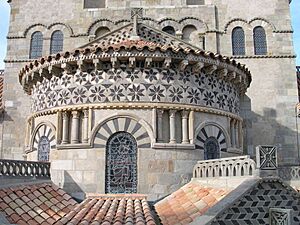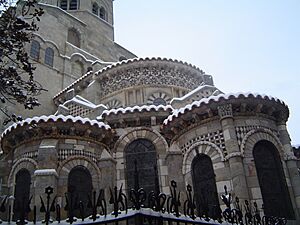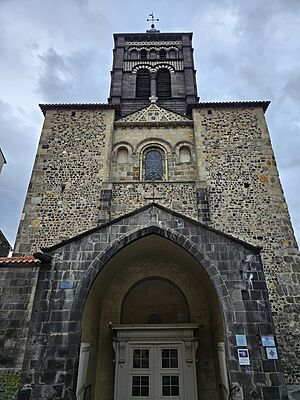Basilica of Notre-Dame du Port facts for kids
The Basilica of Notre-Dame du Port is a very old and important church in Clermont-Ferrand, France. It's a great example of Romanesque architecture, which was popular a long time ago. This church is located in the "Port" area of the city, between Place Delille and the main Clermont-Ferrand Cathedral. For many centuries, from the 900s until the French Revolution (around 1789), groups of priests called canons looked after the church.
History of the Basilica
People believe that a bishop named Avitus of Clermont first built a church here in the 500s. The church you see today was rebuilt in the 1000s or 1100s after it was burned down by the Normans. A group of canons started living and working here in the mid-900s.
The church was officially named a "minor basilica" on May 3, 1886. This title is given by the Pope to churches that are very important.
In the 1800s, a bell tower was added to the church. The old Romanesque roof tiles were also changed to heavy lava slabs. However, these lava slabs were later removed, and the roof was put back to look as close as possible to its original style. A big project to clean and fix the inside of the church happened between 2007 and 2008. Workers cleaned all the stone, removed old cement, and restored the pictures. The crypt, which is an underground room, was not part of this restoration.
On Sunday, December 7, 2008, a special statue of the Blessed Virgin Mary, known as "Our Lady of the Port," was brought back to the church. It had been kept safe in Clermont Cathedral during the restoration work. This event marked the church's reopening to the public.
In 1998, the Basilica of Notre-Dame du Port became a UNESCO World Heritage site. It was included as part of the "Routes of Santiago de Compostela in France," which are old pilgrimage paths.
The name "du Port" means "of the Port." It's thought to come from the church being in the "port" district. In Latin, portus could mean "market" rather than a place for ships. The church was first called Sainte-Marie-Principale. The name Portus or du Port wasn't used until the 1000s. Interestingly, the Port district wasn't actually a big market area in the Middle Ages; other parts of the city were much busier for trade.
What the Basilica Looks Like
This basilica is one of five important Romanesque churches in the Auvergne region of France. The others are the church of Saint-Austremoine in Issoire, the Basilica of Notre-Dame of Orcival, the church of Saint-Nectaire, and the church of Saint-Saturnin.
The church is built from a type of sandstone called arkose. Many people believe its beautiful, balanced design comes from using the "Golden Number" in its measurements.
The church has a Latin cross shape when viewed from above. It has a long main area called a nave, with six sections. On each side of the nave are lower side aisles with simple arched ceilings. There's also a transept, which is the part that crosses the main body of the church, making the "arms" of the cross. Each arm has a round chapel. The main altar area, called the quire, is surrounded by a walkway called an ambulatory. From this walkway, four chapels branch out in a circle. None of these chapels are directly in line with the main axis of the church. This creates a beautiful rounded back part of the church called a chevet, which has lovely mosaics.
The capitals are the decorated tops of the columns. These are some of the best in the Auvergne region. They mostly show scenes from the Bible. Some also show scenes from an old poem called Psychomachia by Prudentius, which is about the battle between good and evil inside a person.
Gallery
-
A carving showing the Dormition (Mary falling asleep) and the Assumption of the Virgin (Mary going to heaven).
See also
 In Spanish: Basílica de Nuestra Señora del Puerto para niños
In Spanish: Basílica de Nuestra Señora del Puerto para niños
- History of medieval Arabic and Western European domes










